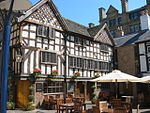Manchester Cathedral

Manchester Cathedral, formally the Cathedral and Collegiate Church of St Mary, St Denys and St George, in Manchester, England, is the mother church of the Anglican Diocese of Manchester, seat of the Bishop of Manchester and the city's parish church. It is on Victoria Street in Manchester city centre and is a grade I listed building. The former parish church was rebuilt in the Perpendicular Gothic style in the years following the foundation of the collegiate body in 1421. Then at the end of the 15th century, James Stanley II (warden 1485–1506 and later Bishop of Ely 1506–1515) was responsible for rebuilding the nave and collegiate choir with high clerestory windows; also commissioning the late-medieval wooden internal furnishings, including the pulpitum, choir stalls and the nave roof supported by angels with gilded instruments. The collegiate church became the cathedral of the new Diocese of Manchester in 1847. It was extensively refaced, restored and extended in the Victorian period, and again following bomb damage during World War II. It is one of fifteen Grade I listed buildings in Manchester.
Excerpt from the Wikipedia article Manchester Cathedral (License: CC BY-SA 3.0, Authors, Images).Manchester Cathedral
Victoria Street, Manchester City Centre
Geographical coordinates (GPS) Address Website External links Nearby Places Show on map
Geographical coordinates (GPS)
| Latitude | Longitude |
|---|---|
| N 53.485277777778 ° | E -2.2447222222222 ° |
Address
Manchester Cathedral
Victoria Street
M3 1SX Manchester, City Centre
England, United Kingdom
Open on Google Maps











